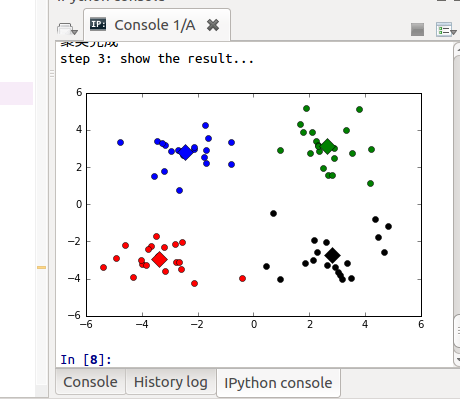kmeans算法思想:
1.从数据集中随机选取k个初始点作为质心。
2.遍历数据集中所有的点,求出每个点到每个质心的距离,找出距离改点最近的质心,并改变此点类型为此质点的类型。
3.重新为每个类别更新其质心。
4.重复2,3,步直到最后两次质心位置相同退出while循环。
补充用python实现的代码,要给python装numpy和matplotlib库,建议直接装anaconda,装好了anaconda默认安装了spyder,里面集成了这两个库,比较方便。
建立kmeans.py文件,编写如下代码:
# -*- coding: utf-8 -*-
from numpy import *
import matplotlib.pyplot as plt
#计算两向量之间的欧式距离,在这里是计算两点之间的距离
def euclDistance(vector1,vector2):
return sqrt(sum(power(vector2-vector1,2)))
#初始化......
#从原始数据中产生随机的k个数据存入centroids
def initCentroids(dataSet,k):
numSamples,dim=dataSet.shape#返回dataSet的行和列
centroids=zeros((k,dim))#创建k行dim列的矩阵
for i in range(k):
index=int(random.uniform(0,numSamples))#从0到numSamples中随机产生一个数
centroids[i,:]=dataSet[index,:]
return centroids
def kmeans(dataSet,k):#此算法用到3个数据集,dataSet:n行两列表示原始数据,clusterAssment:n行两列,第一列表示
#原始数据的类型,第二列表示此点到质心的距离,centriods:k行两列表示点群的质心
numSamples=dataSet.shape[0]
clusterAssment=mat(zeros((numSamples,2)))#clusterAssment中存放点聚类的类别以及与该类别质心的距离
clusterChanged=True
centroids=initCentroids(dataSet,k)#从原始数据中产生随机的k个数据存入centroids,代表k个质心
while clusterChanged:
clusterChanged=False
for i in xrange(numSamples):
minDist=100000.0
minIndex=0
for j in range(k):#从k个质心中选取距离i行这个点最小的一个质心
distance=euclDistance(centroids[j,:],dataSet[i,:])
if distance<minDist:
minDist=distance
minIndex=j
if clusterAssment[i,0]!=minIndex:
clusterChanged=True#直到对于所有的原始数据类别都确定,都不再更新,即
#(所有的clusterAssment[i,0]都等于minIndex)。此标志为false,退出while循环
clusterAssment[i,:]=minIndex,minDist**2
for j in range(k):#更新每个点群的质心
pointsInCluster=dataSet[nonzero(clusterAssment[:,0]==j)[0]]#选取j类的所有点存入pointsInCluster,这里nonzero函数是个难点,可以百度一下
centroids[j,:]=mean(pointsInCluster,axis=0)#对pointInCluster中的数据按列求均值
#kmeans算法不包括这里的代码,这里的代码主要是可以打印清楚质心的移动情况
mark=['or', 'ob', 'og', 'ok', '^r', '+r', 'sr', 'dr', '<r', 'pr']
#画聚类后的图
for i in xrange(numSamples):
markIndex=int(clusterAssment[i,0])
plt.plot(dataSet[i,0],dataSet[i,1],mark[markIndex],markersize=6)
mark=['Dr', 'Db', 'Dg', 'Dk', '^b', '+b', 'sb', 'db', '<b', 'pb']
#画质心
for i in range(k):
plt.plot(centroids[i,0],centroids[i,1],mark[i],markersize=12)
plt.show()
print "聚类完成"
return centroids,clusterAssment
def showCluster(dataSet,k,centroids,clusterAssment):
numSamples,dim=dataSet.shape
if dim!=2:
print "Sorry! I can not draw because the dimension of your data is not 2!"
return 1
mark=['or', 'ob', 'og', 'ok', '^r', '+r', 'sr', 'dr', '<r', 'pr']
if k>len(mark):
print "Sorry! Your k is too large! please contact Zouxy"
return 1
#画聚类后的图
for i in xrange(numSamples):
markIndex=int(clusterAssment[i,0])
plt.plot(dataSet[i,0],dataSet[i,1],mark[markIndex],markersize=6)
mark=['Dr', 'Db', 'Dg', 'Dk', '^b', '+b', 'sb', 'db', '<b', 'pb']
#画质心
for i in range(k):
plt.plot(centroids[i,0],centroids[i,1],mark[i],markersize=12)
plt.show()
本程序所用到的数据集为80个点,可以复制到自己的test.txt文档中与此程序放在同一目录下:
1.658985,4.285136
-3.453687,3.424321
4.838138,-1.151539
-5.379713,-3.362104
0.972564,2.924086
-3.567919,1.531611
0.450614,-3.302219
-3.487105,-1.724432
2.668759,1.594842
-3.156485,3.191137
3.165506,-3.999838
-2.786837,-3.099354
4.208187,2.984927
-2.123337,2.943366
0.704199,-0.479481
-0.392370,-3.963704
2.831667,1.574018
-0.790153,3.343144
2.943496,-3.357075
-3.195883,-2.283926
2.336445,2.875106
-1.786345,2.554248
2.190101,-1.906020
-3.403367,-2.778288
1.778124,3.880832
-1.688346,2.230267
2.592976,-2.054368
-4.007257,-3.207066
2.257734,3.387564
-2.679011,0.785119
0.939512,-4.023563
-3.674424,-2.261084
2.046259,2.735279
-3.189470,1.780269
4.372646,-0.822248
-2.579316,-3.497576
1.889034,5.190400
-0.798747,2.185588
2.836520,-2.658556
-3.837877,-3.253815
2.096701,3.886007
-2.709034,2.923887
3.367037,-3.184789
-2.121479,-4.232586
2.329546,3.179764
-3.284816,3.273099
3.091414,-3.815232
-3.762093,-2.432191
3.542056,2.778832
-1.736822,4.241041
2.127073,-2.983680
-4.323818,-3.938116
3.792121,5.135768
-4.786473,3.358547
2.624081,-3.260715
-4.009299,-2.978115
2.493525,1.963710
-2.513661,2.642162
1.864375,-3.176309
-3.171184,-3.572452
2.894220,2.489128
-2.562539,2.884438
3.491078,-3.947487
-2.565729,-2.012114
3.332948,3.983102
-1.616805,3.573188
2.280615,-2.559444
-2.651229,-3.103198
2.321395,3.154987
-1.685703,2.939697
3.031012,-3.620252
-4.599622,-2.185829
4.196223,1.126677
-2.133863,3.093686
4.668892,-2.562705
-2.793241,-2.149706
2.884105,3.043438
-2.967647,2.848696
4.479332,-1.764772
-4.905566,-2.911070
测试文件a.py:
# -*- coding: utf-8 -*-
"""
Created on Sun Mar 5 12:30:11 2017
@author: chao
"""
from numpy import *
import kmeans
## 读数据
print "step 1: load data..."
dataSet = []
fileIn = open('/home/chao/Desktop/python_work/kmeans/test.txt')
for line in fileIn.readlines():
lineArr = line.strip().split(',')
dataSet.append([float(lineArr[0]), float(lineArr[1])]) #将每一组数据读入列表里面
## 聚类
print "step 2: clustering..."
dataSet = mat(dataSet) #mat函数创建矩阵
k = 4
centroids, clusterAssment = kmeans.kmeans(dataSet, k)
## 画出结果图
print "step 3: show the result..."
kmeans.showCluster(dataSet, k, centroids, clusterAssment)
运行结果图:





 本文详细介绍KMeans聚类算法的原理与实现过程,通过Python代码实现并展示聚类效果。
本文详细介绍KMeans聚类算法的原理与实现过程,通过Python代码实现并展示聚类效果。
















 3268
3268

 被折叠的 条评论
为什么被折叠?
被折叠的 条评论
为什么被折叠?








